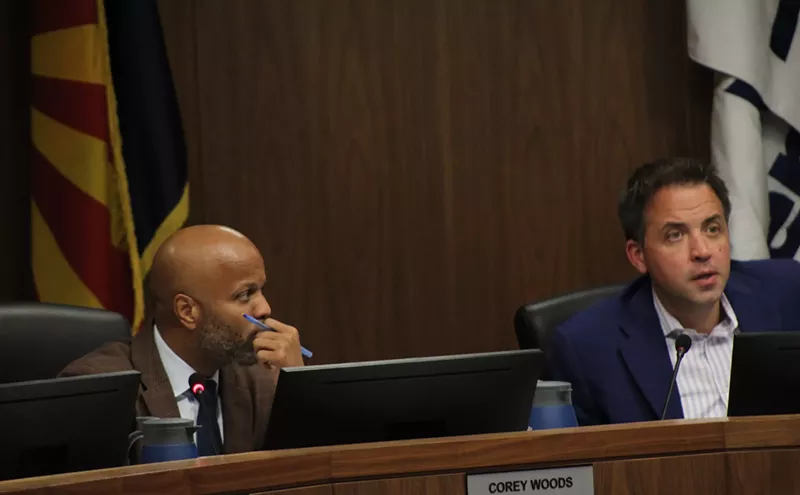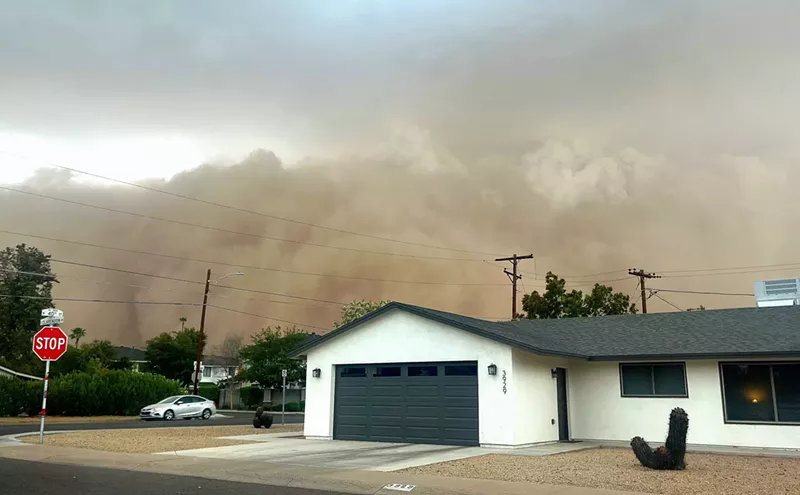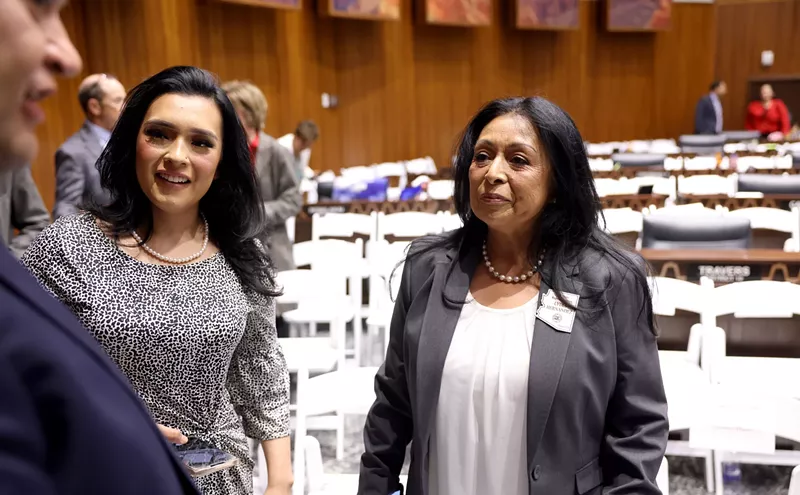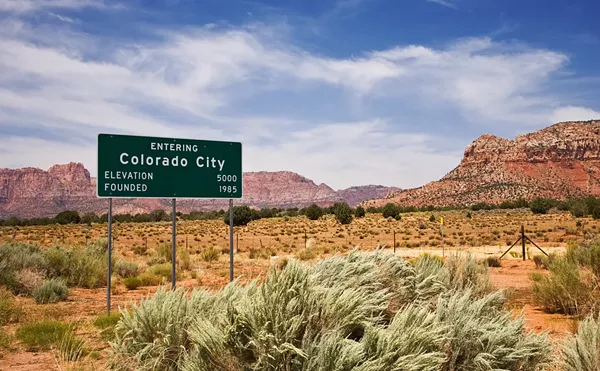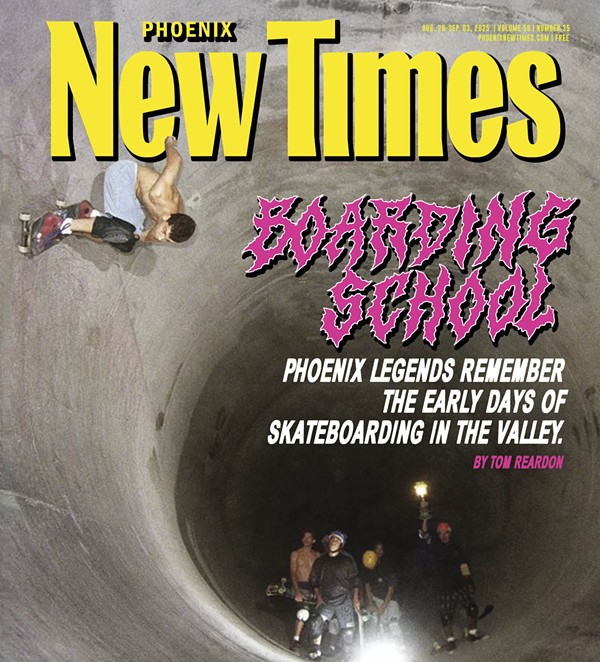Against a backdrop of purple and orange-banded clouds, a line of people slowly entered the Men's Overflow Shelter on Madison Street in downtown Phoenix for the last time. The area was eerily quiet for that time of day. No one shouted, no fights broke out in the street — even the dogs were silent.
Jeremy Huntoon, a case manager for the MOS and East Lot crowd, stood near the shelter, overseeing this nightly procession. Even he was surprised by how quiet it was — for all the media and community attention the closing shelter has received in recent months, he remarked, it seemed odd that no one showed up on the last night.
Acknowledging recent announcements by the city and county that they are allocating more money to housing the homeless, he gestured toward the East Lot, noting that it looked especially full.
"I just hope whatever they do, everyone is safe," he said, turning to face the hundreds of men and women settling in for the night on the asphalt.
Meanwhile, a group of about 75 protesters were gathered about a mile away in Caesar Chavez Plaza. They were finishing an afternoon rally organized by the grassroots activist organization, the Maricopa Alliance for Shelter and Housing. They marched from the State Capitol to the County Superintendent's Office and then to Cesar Chavez to raise awareness of issues facing homeless men and women and to pressure city and county officials to find solutions quickly.
See also: -Maricopa County Emergency-Homeless-Shelter Plan for Phoenix Coming Soon -Huge Homeless Overflow Shelter Closing, and County Has No Plan for Displaced Men
And in fact, earlier Tuesday, Mayor Greg Stanton outlined a more specific plan for rapid re-housing efforts.
On April 9, city and county officials will formally request $1 million from the Phoenix Industrial Development Authority and then another $1 million from the County Industrial Development Authority on April 14. The Valley of the Sun United Way also plans to contribute $500,000. Collectively, the $2.5 million is expected to help house many homeless individuals and comes on top of the 275 housing vouchers the Phoenix City Council allocated earlier this year, and the $1.1 million redirected — or in the process of being redirected — through the county budget to a contract with Community Bridges for housing services.
The mayor's statement also reaffirmed that plans are moving forward to open a building on the Human Services Campus for temporary shelter this summer, but he told Time News that he didn't know specific details about it. "I know that there is an ongoing conversation about finding a new low-demand shelter, but the city hasn't been generally involved. Our focus has been to find housing for people and to end homelessness."
Yet, as we reported recently, representatives from the city, county, and state and the nonprofit sector have been meeting relentlessly to find an indoor alternative to the East Lot — a space that every public official has said is not being closed any time soon.
While the group is still working out details, the skeleton of the plan has been established: The day room at the Lodestar Day Resource Center and part of the dining room at St. Vincent de Paul will stay open overnight, providing an air-conditioned space for people to sleep. The group is working to get other agencies on the Human Services Campus to open up more space.
Bruce Liggett, director of the Maricopa County Human Services Department, and one of the leaders in this planning effort, says that even though they have a lot of work left to do, they've come a long way. "We're down to the level of detail where we're talking with CASS about using the mats from MOS," he says.
After securing the final details with the cooperating parties, Liggett and others will present the plan to the Maricopa County Board of Supervisors. If the board approves it, the money currently going to the MOS and East Lot will be used instead to fund these new temporary shelter spaces.
Like the MOS, these rooms will operate as "wet shelters," meaning intoxicated individuals won't automatically be turned away, though no drugs or alcohol will be permitted inside. There will be a basic bag search at the entrance and people will need a campus ID to get inside. (As of next Monday, the campus Welcome Center, which issues IDs, will be open until 9 p.m. permanently.)
Critics worry that an ID requirement will deter some individuals from going into the shelter space because, they say, many homeless men and women are wary to trust anyone. But Liggett isn't too worried.
Earlier this year, CASS and other affiliated agencies conducted a massive assessment of individuals staying in the MOS and East Lot. They collected details such as name and age, as well as information about their housing, health, and service needs.
"Before we began to conduct assessments, people had their own ideas of who people [in the East Lot] were," Liggett says. "There were lots of myths like that people wouldn't give us their names, and that the parking lot had a high percentage of sex offenders." The assessment turned up about 15 sex offenders (out of hundreds of people), which was lower than expected. And there wasn't much pushback when people were required to give their names.
(New Times has been told by multiple case managers, CASS staff, and police officers that because they've all worked with this population for years, they knew the names of those who sleep there, so the concern would be a moot point.)
The group also used information from the assessment to help make decisions about allocating resources — they found, for instance, that 60 percent of the individuals sleeping in the MOS and East Lot would qualify for rapid re-housing, meaning that this is where a big push needs to be directed.
Liggett also explains that the changes they're planning are part of a philosophical shift in how Maricopa County handles emergency shelter operations. While in the past, CASS has taken "a security approach" to managing the MOS and East Lot — hiring off-duty police officers and private security staff — the new approach, which CASS is not charged with running, is centered on client engagement.
Instead of uniformed officers, there will be case managers and other professionals trained to work with homeless populations. (In the future, there may be opportunities for community volunteers to get training to help staff the overnight spaces.)
There still are plenty of questions about the new temporary overnight shelter spaces that need to be answered — who will be allowed to stay in them, for instance. It's an important consideration because in addition to the dozen or so convicted sex offenders who sleep in the lot — and who are categorically barred from the official CASS shelters — there is a larger population of individuals who have been kicked off the Human Service Campus for violent behavior.
Details about whether these groups will be allowed to sleep in the new spaces and if so, under what conditions, are not yet clear. (Getting kicked out of CASS, however, would not preclude admittance, because the CASS buildings are not being used.)
As for the number of people the spaces can accommodate, Liggett tells New Times that the exact figure has not been tabulated, but he already knows that he can't commit to having spots for everyone in the East Lot. That being said, other shelters in the area have come forward and offered to house a few more individuals, and the new funding for rapid re-housing will help decrease the size of the population who need emergency shelter.
Those doing the planning understand that the public wants results overnight, but they caution that coordinating big programmatic changes take time. The group is aiming to hire and train new staff over the next four to six weeks, with a target date of May 15 to open the new spaces.
Until then, hundreds will continue to sleep in the East Lot.
Got a tip? Send it to: Miriam Wasser.
Follow Valley Fever on Twitter at @ValleyFeverPHX. Follow Miriam Wasser at @MiriamWasser.




